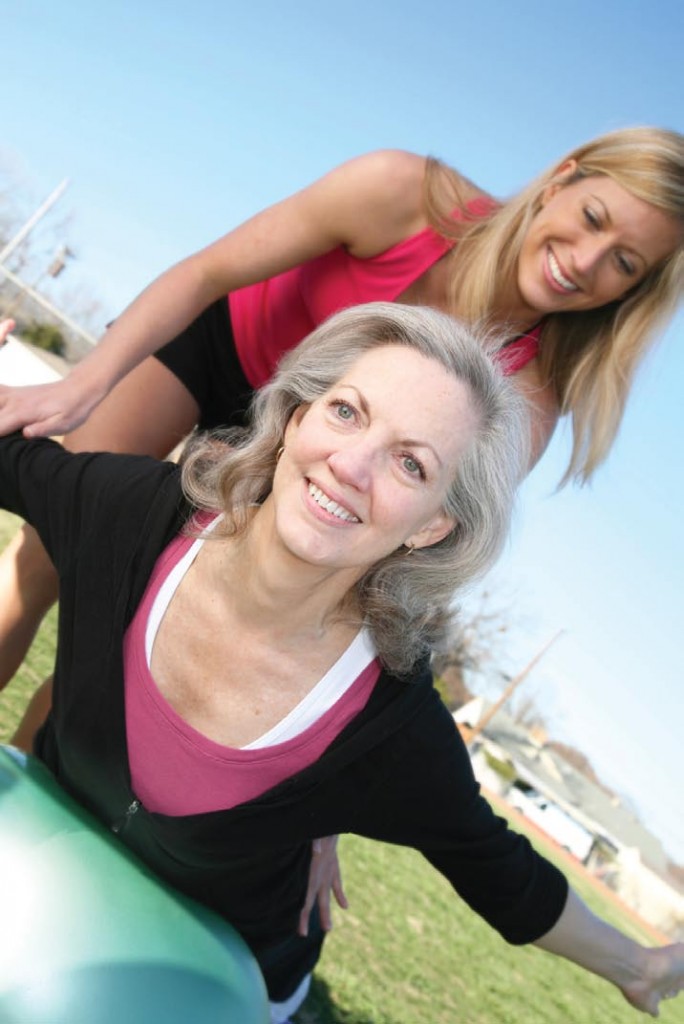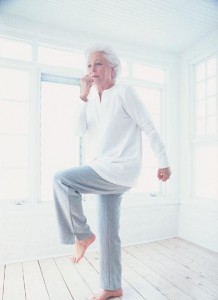By Michelle Porter Tiernan
Pilates is an exercise for all ages. No one illustrated that better than creator Joseph Pilates. He practiced and taught the exercise he developed well into his mid-80s while sporting a physique of a man half his age.
A series of movements performed on special equipment and a padded mat, Pilates is an ideal exercise for seniors because it can improve balance, flexibility and posture. In addition, Pilates goes beyond physical benefits to provide relief from mental stress.
Caring for a loved one with Alzheimer’s disease is an emotional task. Often caregivers feel that circumstances are out of their control. Pilates can offer relief by promoting mind-body awareness.

Better Physical and Mental Control
“Pilates is all about healing a body through movement,” says Jamie Sharpe, a Power Pilates and Pilates Method Alliance certified instructor in Cary, N.C. “Pilates is a non-impact form of exercise that really teaches people how to be in better control of their life and health.”
Proper breathing, body alignment and precise movements are the principles of Pilates. By emphasizing concentration of breathing with movement, the exercise not only builds awareness of the body but also enhances mental clarity.
“Movement heals the body both physically and mentally,” says Sharpe, who is also a studio coordinator for Triangle Pilates and Cary Yoga Center. “The Pilates method improves stamina, coordination, strength and mobility, and helps to rejuvenate the body.”
Humble Beginnings
Originally invented by Joseph Pilates during his work with bedridden patients, the exercise has evolved into a popular regimen practiced by dancers, athletes and celebrities. According to the Pilates Method Alliance, an international association dedicated to certified Pilates instruction, Pilates invented the exercise during World War I.
While under forced internment as a German national in England, Joseph taught fellow internment camp members the movements he had developed from years studying yoga, Zen Buddhism, and ancient Greek and Roman exercises. At this time, he began to develop the system of Pilates movements on the floor known as “mat work.”
A few years later, Joseph was transferred to another internment camp, where he became a nurse and caretaker to bedridden detainees suffering from wartime disease and physical injuries. It was here that Joseph started to invent equipment for rehabilitation. He took springs from the beds and fashioned them into resistance exercise machines for bedridden patients.
In 1926, Joseph and his wife Clara emigrated from Germany to New York City, where they opened the first Pilates studio. Joseph taught the Pilates method using the experiences and equipment inspired by his work with internment camp detainees.
Exercise Equipment
Today, the equipment that Joseph first developed for bedridden internment camp members has not changed much from its original design, although it has evolved.

Two examples of Pilates-based equipment are the reformer and the cadillac. The reformer is designed with pulleys and cables that are pushed or pulled with hands or feet. Handholds, supports and positioning bars are used to stretch the body into positions unreachable on the mat alone.
The cadillac is a raised, horizontal tabletop surrounded by a four-poster frame on which bars, springs, straps and levers are fixed. It challenges the core abdominal muscles, strengthens the back and stretches the entire body.
“I personally think the reformer and the cadillac are amazing for seniors,” says Sharpe. “Each piece of equipment offers assistance and resistance and helps reinforce the mat exercises.”
Mat-based Pilates are movements performed on the floor using gravity and one’s own body weight to provide resistance. Exercise on the mat emphasizes coordinated breathing and is used for conditioning of deep, supporting muscles of the body to improve posture, coordination and balance.
Gentle Pilates for Seniors
A certified Pilates instructor and rehabilitation specialist based in Encinitas, Calif., Heidi Lerner, M.A., teaches Pilates to seniors ranging in age from 50s to 80s. She offers a modified course called Gentle Pilates that is especially useful for seniors.
“If taught appropriately, each will get what they can handle—not too much toning or too much stretching,” says Lerner. “Gentle Pilates helps with greater range of motion. The tone and flexibility leave my students with a spring in their step.”
Lerner teaches mat classes as well as private or semi-private sessions with equipment. “We work with exercises that strengthen the abdomen, roll and lengthen the spine, and provide circular movement of the limbs to increase flexibility in the shoulders and stability in the hips.”
How to Get Started
To find a certified Pilates instructor, visit the Pilates Method Alliance or call 866-573-4945. Lerner advises choosing an instructor who teaches an adaptable style of Pilates that is sensitive to the needs of seniors.
Pilates can be adapted to meet many individual needs, says Sharpe. “Pilates can be modified to work with the client who has osteoporosis as well as the one with a double hip replacement.”
For loved ones with Alzheimer’s disease, Lerner recommends either private or semi-private instruction to check form and prevent injury. “Ideally, if they could take classes and just learn for home practice some fundamentals such as breathing and pelvic rolling, that would be of tremendous help.”
Source: www.ALZinfo.org. Author: Michelle Porter Tiernan, Preserving Your Memory: The Magazine of Health and Hope; Spring 2009.










